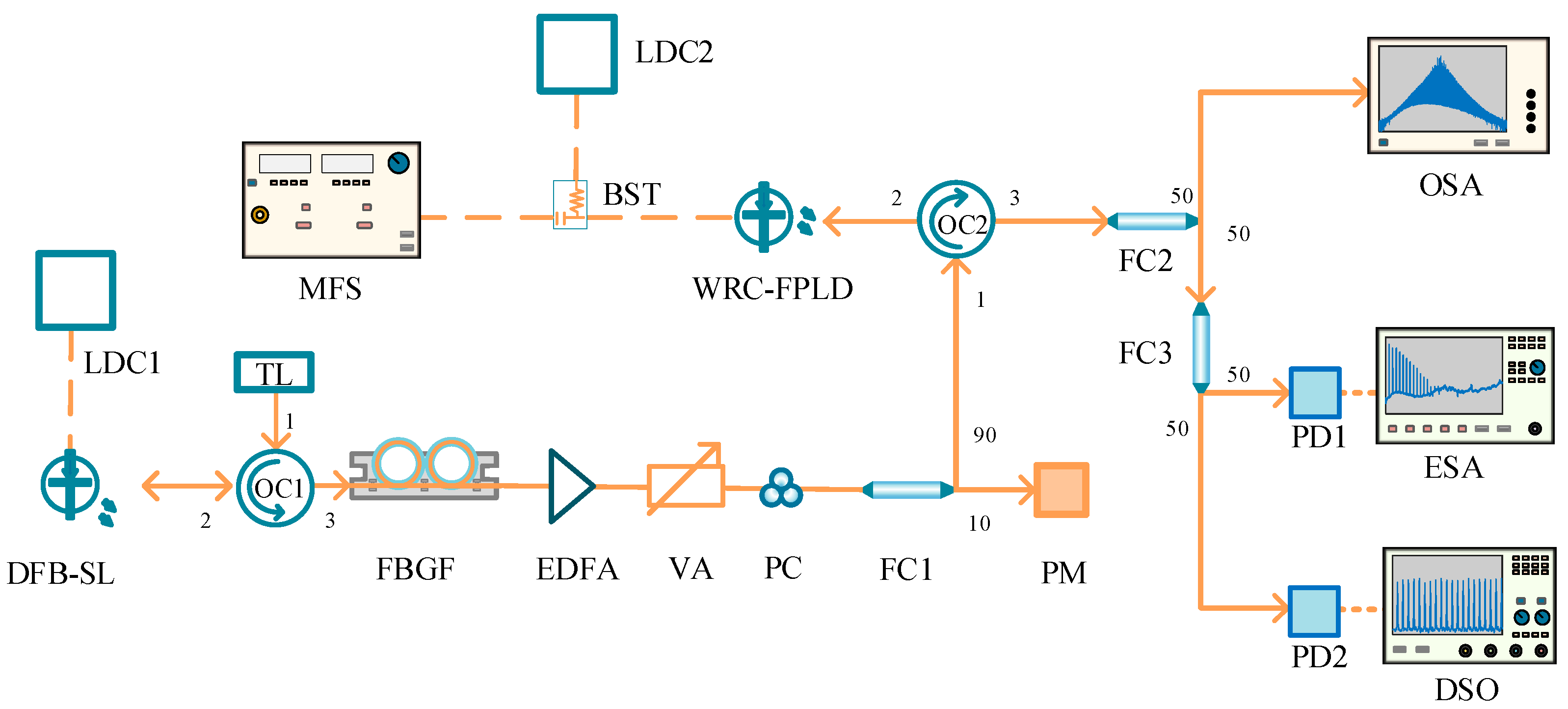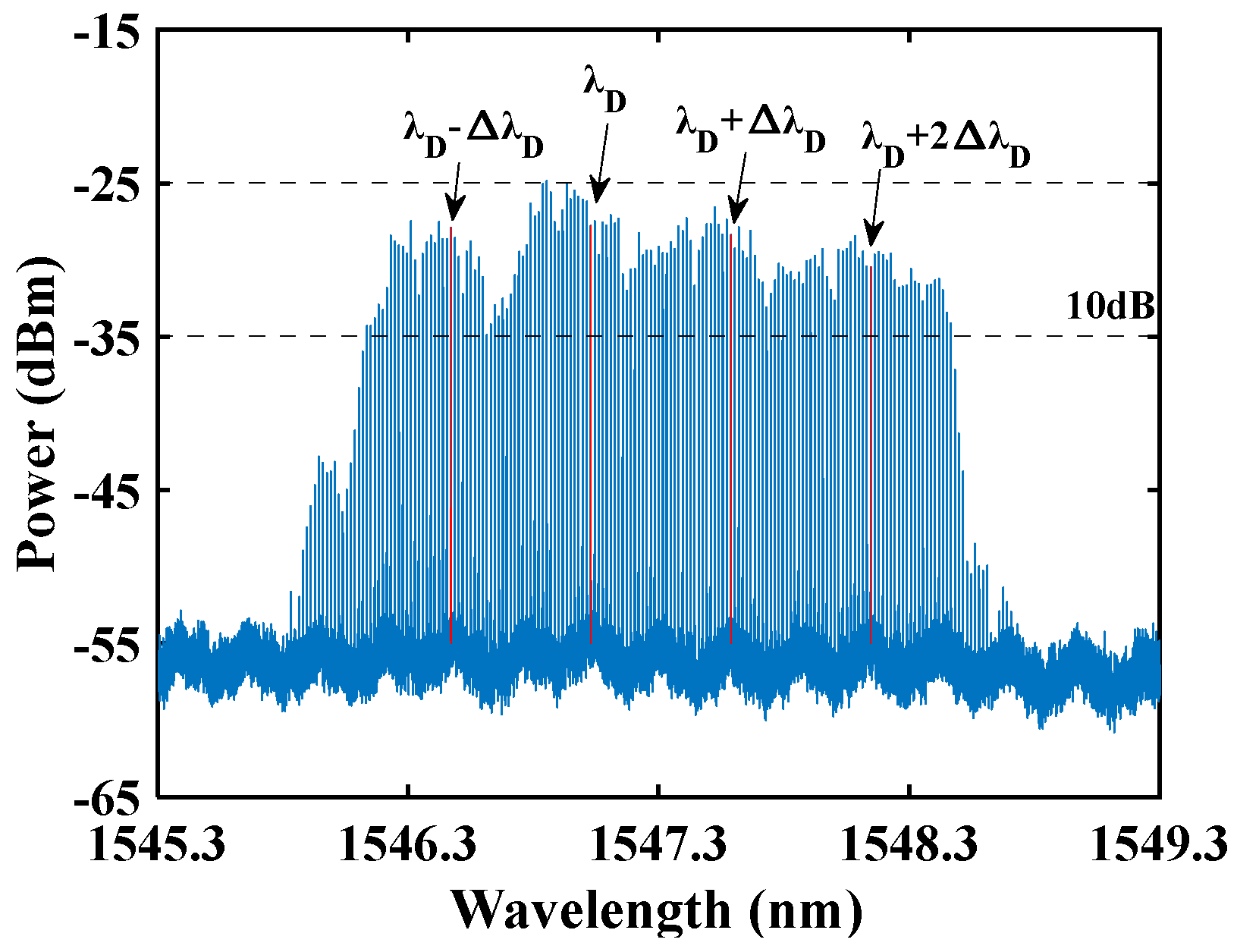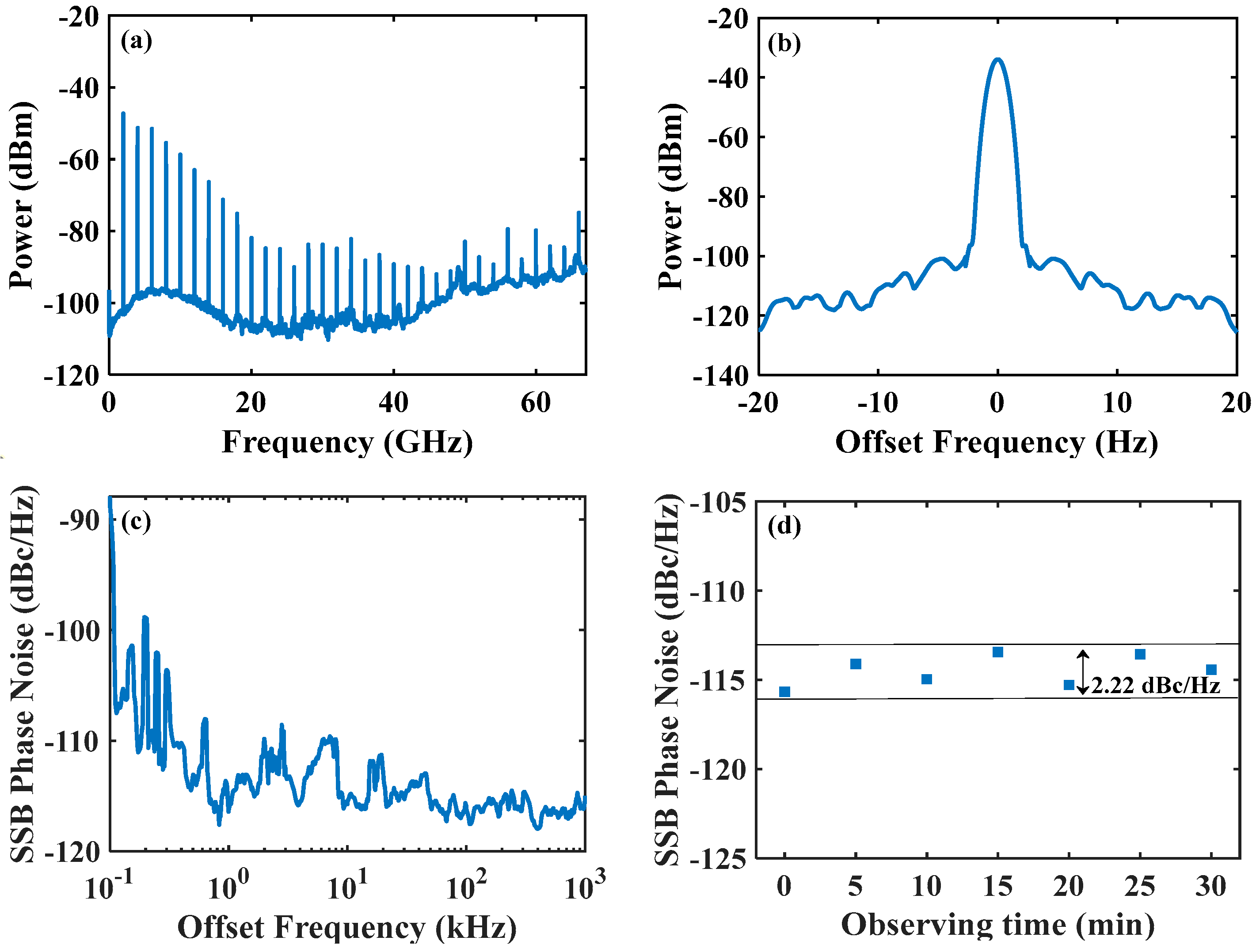Broadband Optical Frequency Comb Generation Utilizing a Gain-Switched Weak-Resonant-Cavity Fabry–Perot Laser Diode under Multi-Wavelength Optical Injection
Abstract
:1. Introduction
2. Experimental Setup and Theory
3. Results and Discussion
4. Conclusions
Author Contributions
Funding
Institutional Review Board Statement
Informed Consent Statement
Data Availability Statement
Conflicts of Interest
References
- Fortier, T.; Baumann, E. 20 years of developments in optical frequency comb technology and applications. Commun. Phys. 2019, 2, 153. [Google Scholar] [CrossRef]
- Holzwarth, R.; Udem, T.; Hänsch, T.W.; Knight, J.C.; Wadsworth, W.J.; Russell, P.S.J. Optical frequency synthesizer for precision spectroscopy. Phys. Rev. Lett. 2000, 85, 2264–2267. [Google Scholar] [CrossRef]
- Wang, Q.; Wang, Z.; Zhang, H.; Jiang, S.L.; Wang, Y.Y.; Jin, W.; Ren, W. Dual-comb photothermal spectroscopy. Nat. Commun. 2022, 13, 2181. [Google Scholar] [CrossRef] [PubMed]
- Newman, Z.L.; Maurice, V.; Drake, T.; Stone, J.R.; Briles, T.C.; Spencer, D.T.; Fredrick, C.; Li, Q.; Westly, D.; Ilic, B.R.; et al. Architecture for the photonic integration of an optical atomic clock. Optica 2019, 6, 680–685. [Google Scholar] [CrossRef]
- Udem, T.; Holzwarth, R.; Hänsch, T.W. Optical frequency metrology. Nature 2002, 416, 233–237. [Google Scholar] [CrossRef]
- Pfeifle, J.; Vujicic, V.; Watts, R.T.; Schindler, P.C.; Weimann, C.; Zhou, R.; Freude, W.; Barry, L.P.; Koos, C. Flexible terabit/s Nyquist-WDM super-channels using a gain-switched comb source. Opt. Express 2015, 23, 724–738. [Google Scholar] [CrossRef] [PubMed]
- Browning, C.; Elwan, H.H.; Martin, E.P.; O’Duill, S.; Poette, J.; Sheridan, P.; Farhang, A.; Cabon, B.; Barry, L.P. Gain-Switched Optical Frequency Combs for Future Mobile Radio-Over-Fiber Millimeter-Wave Systems. J. Light. Technol. 2018, 36, 4602–4610. [Google Scholar] [CrossRef]
- Zhou, X.; Zheng, X.P.; Wen, H.; Zhang, H.Y.; Guo, Y.L.; Zhou, B.K. All optical arbitrary waveform generation by optical frequency comb based on cascading intensity modulation. Opt. Commun. 2011, 284, 3706–3710. [Google Scholar] [CrossRef]
- Li, P.L.; Ma, X.L.; Shi, W.H.; Xu, E.M. Optical arbitrary waveform generation based on multi-wavelength semiconductor fiber ring laser. Opt. Laser Technol. 2017, 94, 228–233. [Google Scholar] [CrossRef]
- Haus, H.A. Mode-locking of lasers. IEEE J. Sel. Top. Quantum Electron. 2000, 6, 1173–1185. [Google Scholar] [CrossRef]
- Jones, D.J.; Diddams, S.A.; Ranka, J.K.; Stentz, A.; Windeler, R.S.; Hall, J.L.; Cundiff, S.T. Carrier-Envelope Phase Control of Femtosecond Mode-Locked Lasers and Direct Optical Frequency Synthesis. Science 2000, 288, 635–639. [Google Scholar] [CrossRef] [PubMed]
- Li, D.; Wu, S.B.; Liu, Y.; Guo, Y.F. Flat optical frequency comb generation based on a dual-parallel Mach–Zehnder modulator and a single recirculation frequency shift loop. Appl. Opt. 2020, 59, 1916–1923. [Google Scholar] [CrossRef] [PubMed]
- Ujjwal; Kumar, R. Optical Frequency Comb Generator Employing Two Cascaded Frequency Modulators and Mach–Zehnder Modulator. Electronics 2023, 12, 2762. [Google Scholar] [CrossRef]
- Yang, W.Y.; Xia, G.Q.; Jiang, Z.F.; Deng, T.; Lin, X.D.; Jin, Y.H.; Xiao, Z.Z.; Yue, D.Z.; Hu, C.X.; Cui, B.; et al. Experimental investigation on wideband optical frequency comb generation based on a gain-switched 1550 nm multi-transverse mode vertical-cavity surface-emitting laser subject to dual optical injection. IEEE Access 2020, 8, 170203–170210. [Google Scholar] [CrossRef]
- Lakshmijayasimha, P.D.; Anandarajah, P.M.; Landais, P.; Kaszubowska-Anandarajah, A. Optical Frequency Comb Expansion Using Mutually Injection-Locked Gain-Switched Lasers. Appl. Sci. 2021, 11, 7108. [Google Scholar] [CrossRef]
- Jain, G.; Gutierrez-Pascual, D.; Wallace, M.; Donegan, J.; Anandarajah, P. Experimental Investigation of External Optical Injection and its Application in Gain-Switched Wavelength Tunable Optical Frequency Comb Generation. J. Light. Technol. 2021, 39, 5884–5895. [Google Scholar] [CrossRef]
- Zhang, J.H.; Fan, L.; Wu, Z.M.; Gou, C.H.; Luo, Y.; Xia, G.Q. Broadband and tunable optical frequency comb based on 1550 nm verticalcavity surface-emitting laser under pulsed current modulation and optical injection. Acta Phys. Sin. 2023, 72, 014207. [Google Scholar] [CrossRef]
- Ren, H.P.; Fan, L.; Liu, N.; Wu, Z.M.; Xia, G.Q. Generation of Broadband Optical Frequency Comb Based on a Gain-Switching 1550 nm Vertical-Cavity Surface-Emitting Laser under Optical Injection. Photonics 2020, 7, 95. [Google Scholar] [CrossRef]
- Pan, S.L.; Yao, J.P. Wideband and frequency-tunable microwave generation using an optoelectronic oscillator incorporating a Fabry–Perot laser diode with external optical injection. Opt. Lett. 2010, 35, 1911–1913. [Google Scholar] [CrossRef]
- Zhou, R.; Latkowski, S.; O’Carroll, J.; Phelan, R.; Barry, L.P.; Anandarajah, P. 40nm wavelength tunable gain-switched optical comb source. Opt. Express 2011, 19, B415–B420. [Google Scholar] [CrossRef]
- Pascual, M.D.G.; Zhou, R.; Smyth, F.; Shao, T.; Anandarajah, P.M.; Barry, L. Dual mode injection locking of a Fabry-Pérot laser for tunable broadband gain switched comb generation. In Proceedings of the 2015 European Conference on Optical Communication, Valencia, Spain, 27 September 2015. [Google Scholar]
- Lakshmijayasimha, P.D.; Kaszubowska-Anandarajah, A.; Srivastava, M.; Martin, E.P.; Anandarajah, P.M. Generation of a Wideband OFC by the Correlation of Multiple Modes of a Gain-Switched Fabry Pérot Laser. J. Light. Technol. 2023, 41, 5084–5090. [Google Scholar] [CrossRef]
- Lin, G.R.; Wang, H.L.; Lin, G.C.; Huang, Y.H.; Lin, Y.H.; Cheng, T.K. Comparison on Injection-Locked Fabry–Perot Laser Diode With Front-Facet Reflectivity of 1% and 30% for Optical Data Transmission in WDM-PON System. J. Light. Technol. 2009, 27, 2779–2785. [Google Scholar]
- Lin, S.Y.; Chi, Y.C.; Su, Y.C.; Li, Y.C.; Lin, G.R. An Injection-Locked Weak-Resonant-Cavity Laser Diode for Beyond-Bandwidth Encoded 10-Gb/s OOK Transmission. IEEE Photonics J. 2015, 7, 7200309. [Google Scholar] [CrossRef]
- Aldaya, I.; Gosset, C.; Wang, C.; Campuzano, G.; Grillot, F.; Castañón, G. Periodic and aperiodic pulse generation using optically injected DFB laser. Electron. Lett. 2015, 51, 280–282. [Google Scholar] [CrossRef]
- Zhang, T.T.; Xiong, J.T.; Zheng, J.L.; Chen, X.F.; Pu, T. Wideband tunable single bandpass microwave photonic filter based on FWM dynamics of optical-injected DFB laser. Electron. Lett. 2016, 52, 57–59. [Google Scholar] [CrossRef]
- Shih, T.T.; Tseng, P.H.; Lai, Y.Y.; Cheng, W.H. Compact TO-CAN Header With Bandwidth Excess 40 GHz. J. Light. Technol. 2011, 29, 2538–2544. [Google Scholar] [CrossRef]
- Chi, Y.C.; Li, Y.C.; Lin, G.R. Specific Jacket SMA-Connected TO-Can Package FPLD Transmitter With Direct Modulation Bandwidth Beyond 6 GHz for 256-QAM Single or Multisubcarrier OOFDM up to 15 Gb/s. J. Light. Technol. 2013, 31, 28–35. [Google Scholar] [CrossRef]
- Cheng, M.C.; Chi, Y.C.; Tsai, C.T.; Lin, C.Y.; Lin, G.R. TO-56-can packaged colorless WRC-FPLD for QAM OFDM transmission at 42 Gbit/s over 25-km SMF. Opt. Express 2015, 23, 22676–22690. [Google Scholar] [CrossRef]
- Yang, Q.; Wu, Z.M.; Wu, J.G.; Xia, G.Q. Influence of injection patterns on chaos synchronization performance between a multimode laser diode and a single-mode laser. Opt. Commun. 2008, 281, 5025–5030. [Google Scholar] [CrossRef]
- Rosado, A.; Pérez-Serrano, A.; Tijero, J.M.G.; Valle, Á.; Pesquera, L.; Esquivias, I. Experimental study of optical frequency comb generation in gain-switched semiconductor lasers. Opt. Laser Technol. 2018, 108, 542–550. [Google Scholar] [CrossRef]
- Peng, B.Y.; Yuan, C.Z.; Zhang, R.M.; Shen, S.; Zhang, Z.C.; Li, J.R.; Lin, Y.; Deng, G.W.; Wang, Y.; Song, H.Z.; et al. Progress in Gain-Switched Semiconductor Lasers for Quantum Communication. Acta Opt. Sin. 2022, 42, 0327007. [Google Scholar]
- Liu, Y.D.; Xia, G.Q.; Fan, L.; Zhang, J.H.; Lin, G.R.; Liu, J.Q.; Wu, Z.M. Optical Frequency Comb Generation Based on a Current-modulated Weak-resonant-cavity Fabry-Perot Laser Diode Subject to Optical Injection. Acta Photonica Sin. 2024, 53, 0553112. [Google Scholar]
- Rosado, A.; Pérez-Serrano, A.; Tijero, J.M.G.; Valle, Á.; Pesquera, L.; Esquivias, I. Enhanced optical frequency comb generation by pulsed gain-switching of optically injected semiconductor lasers. Opt. Express 2019, 27, 9155–9163. [Google Scholar] [CrossRef] [PubMed]







| Ref. | Year | Key Expansion Component | Number of Wavelengths Contained in Injected Light | OFC FSR (GHz) | OFC Bandwidth (GHz) | NCL |
|---|---|---|---|---|---|---|
| [20] | 2011 | OI-GS FP-LD + phase modulator | 1 | 10 | ~160 | 16 |
| [21] | 2015 | OI-GS two-mode FP-LD | 1 | 6.25 | ~325 | 52 |
| [16] | 2021 | OI-GS FP-LD | 1 | 12.5 | ~100 | 9 |
| [22] | 2023 | MWIL introduction to GS FP-LD | 13 | 6.25 | ~275 | 44 |
| This work | 2024 | MWIL introduction to GS WRC-FPLD | 4 | 2 | ~292 | 147 |
Disclaimer/Publisher’s Note: The statements, opinions and data contained in all publications are solely those of the individual author(s) and contributor(s) and not of MDPI and/or the editor(s). MDPI and/or the editor(s) disclaim responsibility for any injury to people or property resulting from any ideas, methods, instructions or products referred to in the content. |
© 2024 by the authors. Licensee MDPI, Basel, Switzerland. This article is an open access article distributed under the terms and conditions of the Creative Commons Attribution (CC BY) license (https://creativecommons.org/licenses/by/4.0/).
Share and Cite
Tao, Y.; Wang, Q.; Ou, P.; Xia, G.; Wu, Z. Broadband Optical Frequency Comb Generation Utilizing a Gain-Switched Weak-Resonant-Cavity Fabry–Perot Laser Diode under Multi-Wavelength Optical Injection. Photonics 2024, 11, 912. https://doi.org/10.3390/photonics11100912
Tao Y, Wang Q, Ou P, Xia G, Wu Z. Broadband Optical Frequency Comb Generation Utilizing a Gain-Switched Weak-Resonant-Cavity Fabry–Perot Laser Diode under Multi-Wavelength Optical Injection. Photonics. 2024; 11(10):912. https://doi.org/10.3390/photonics11100912
Chicago/Turabian StyleTao, Yuhong, Qiupin Wang, Pu Ou, Guangqiong Xia, and Zhengmao Wu. 2024. "Broadband Optical Frequency Comb Generation Utilizing a Gain-Switched Weak-Resonant-Cavity Fabry–Perot Laser Diode under Multi-Wavelength Optical Injection" Photonics 11, no. 10: 912. https://doi.org/10.3390/photonics11100912





